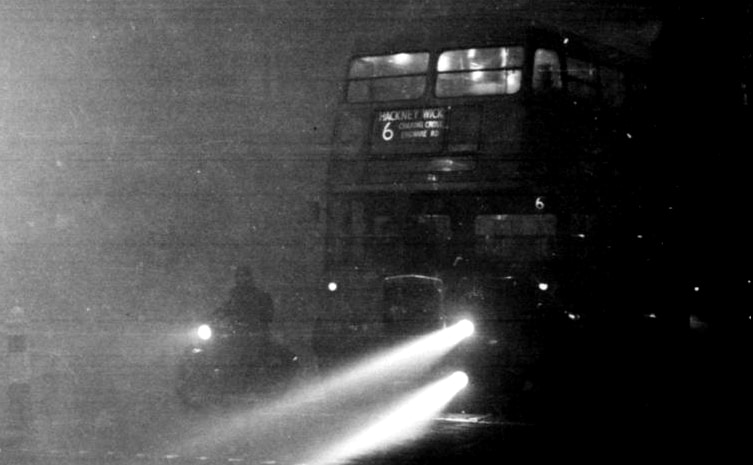There is an old joke about a particularly polluted city in south Wales which involves asking someone whether that orb in the sky is the moon or the sun. The reply: “I don’t know – I’m from Port Talbot!”
In Pittsburgh, the air quality was almost as bad in the 1970s – when they used to keep the streetlights on in the daytime. I don’t know if that story was absolutely true, but it wasn’t a joke…
In that respect, the post-industrial era hasn’t been all bad. De-industrialisation has made our air a little cleaner and more breathable.
Noel Coward once described London as ”smokily enchanted” in his song ‘London Pride’ (“Taken so for granted for a thousand years.”)
But it
It is true that the two cities where I was living in the late 1970s – London and Oxford – look very different now to their blackened facades in those days. That was thanks partly to the smoke control legislation in the early 1950s, in response to the Great Smog in December 1952 – which killed about 12,000 Londoners.
That was also the period when the orange low-pressure sodium-vapour streetlights that every city had begun to be replaced by the ubiquitous high-pressure sodium lamps that began to emerge in the late 1970s. Before that, everything was seen through an orange glow that interfered with colours at night.
In fact, one of the inaccuracies about gritty TV dramas about 1970s spies is that Westminster looked very different in those days. When the coronation happens in two months time, it will be a white refaced and clean abbey, not the grimy black creature that hosted the last coronation in 1953. The Westminster of Asquith, Churchill and Attlee was a far grimier place than it is now.
And the railway stations on the main line – by the mid-1980s, they had all gone from ancient asphalt flooring to brilliant polished white.
No wonder we all felt a little lighter by then.
Margaret Thatcher didn’t clean up all those buildings and change the streetlights. But she did preside over the de-industrialisation of the UK, because – on her watch – the pound became a petro-currency and this priced British exports out of world markets. This led to miles of abandoned post-industrial tracts of wasteland outside so many UK cities.
And although we are rightly proud of the way the UK has managed to decarbonise our energy supply – that has as much to do with the aftermath of the 1984 miners’ strike as anything else. If the pits had not been closed, we would probably be still subsidising the mines like they do in Poland.
What I am saying is that the UK has been governed by two deeply conservative political forces for most of the past century – which seem to have taken the right directions despite themselves.
Let me give you two examples. First, the so-called ‘Motorway Box’, the inner London ring road.
Because just as they were beginning the big clean-up in London, the Tories ran the Greater London Council under Sir Horace Cutler and were pushing through this dreadful proposal – which would have increased traffic in London more than it has actually been increased (because building roads encourages cars, right?) Luckily voters kicked him out in 1975.
But those Conservatives under Churchill and Macmillan who successfully cleaned the air of smoke and sulphur failed to worry at all that the smog might just be replaced by asthma-causing NOx and SOx because of all the extra traffic generated by all that extra roadspace.
And by the way – since we are on the subject of peculiar policy causes and effects – so many inner urban motorway projects around the UK were voted down in those days, but many of the 1981 riots took place in neighbourhoods that had been blighted by abandoned motorway schemes, like Brixton and Toxteth.
Then there was Glasgow. Because one of the side-effects of post-industrial air quality was that Glasgow was finally able to show the collection of shipowner Sir William Burrell, which he had given to them in 1944 – partly to spite Edinburgh, which had nurtured hopes, because they had removed his iron railings in 1940.
One of his stipulations was that it would not be put on show until a gallery had been purpose-built to house it and until the air quality had improved enough.
The Burrell Collection opened in 1983 and underpinned city council’s Glasgow’s Miles Better campaign.
Yet while the new gallery was being built on Polok Park, the Labour council was still emptying the old brownstone communities of the Gorbals and decanting the working class population out to massive, soulless edge-of-town estates like Easterhosue and Castlemilk.
What I am saying is that there are two lessons from all this…
- Both sides of the political divide are more similar than they pretend.
- Sometimes the right things happen for the wrong reasons.
I wonder, for example, if all the political rhetoric about ‘growth’ these days might actually prove impossible to achieve any more, Because – no matter what anyone says – growth is just not going to happen any more.





